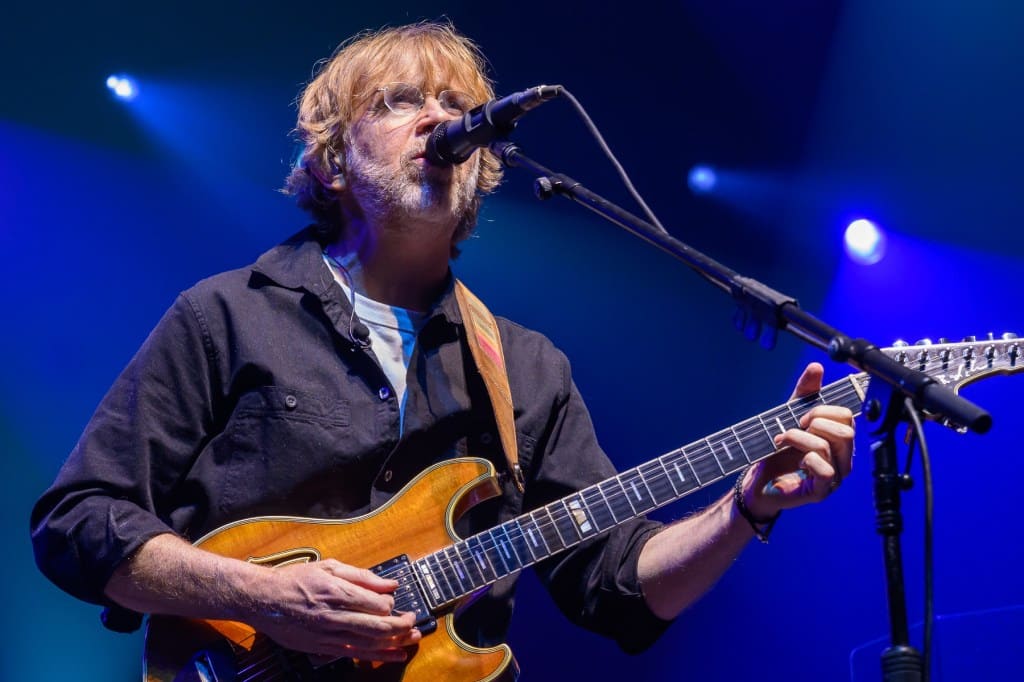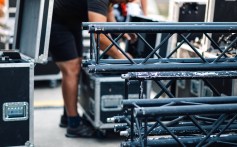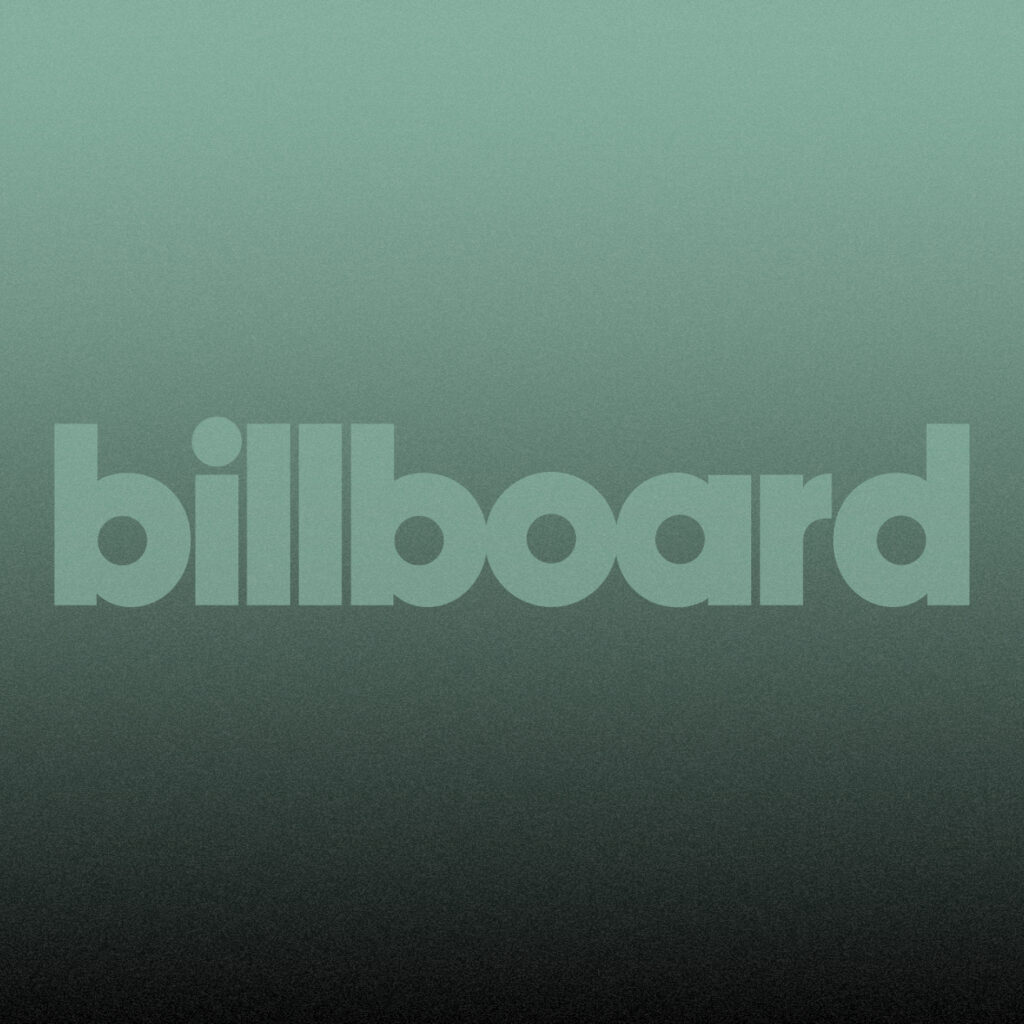Touring
Trending on Billboard Phish is heading back to Las Vegas. The iconic jam-rock group will return to Sphere next spring for a nine-show residency, expanding on the four-night run that marked its acclaimed debut at the venue in 2024. The new dates — April 16–18, April 23–25 and April 30–May 2, 2026 — were announced […]
Trending on Billboard Oak View Group (OVG) has officially named Chris Granger as CEO, elevating the veteran sports and live-entertainment executive after five months in the interim CEO role. The appointment is effective immediately. Granger replaces former CEO and company founder Tim Leiweke, who was indicted earlier this year on federal bid-rigging charges related to […]
Trending on Billboard
Key Investment Group (KIG) is asking a federal judge to throw out a recently filed Federal Trade Commission (FTC) lawsuit against the ticket resale company over alleged violations of the Better Online Ticket Sales (BOTS) Act.
In August, the FTC filed suit against KIG, alleging the company violated the BOTS Act when it purchased thousands of Taylor Swift tickets for her 2023-2024 Eras Tour and resold them for more than $1 million in profit. The lawsuit was filed days before a similar complaint was filed against Ticketmaster for allegedly refusing to enforce its own rules against scalpers and allowing unrestricted resale on its platform. Since then, Ticketmaster has made changes to its resale policies and, like KIG, has argued that the FTC is misapplying the BOTS Act.
Related
The FTC sued KIG in August, alleging the Colorado-based ticket resale operation used networks of accounts, IP masking, SIM boxes and other technical tools to evade Ticketmaster’s ticket-purchasing limits and acquire hundreds of high-demand tickets for resale. The agency claims these tactics “circumvented” the ticketing giant’s security controls in violation of the BOTS Act.
KIG is the first of the two firms to file a motion to dismiss. In a sweeping 36-page missive filed on Nov. 24, KIG attorney Bezalel A. Stern with law firm Manatt, Phelps and Phillips argues that the FTC’s complaint attempts to regulate long-established broker practices — like using multiple IP addresses to buy tickets or operating dozens of Ticketmaster accounts — that do not involve bots.
“KIG does not use bots. KIG does not circumvent any security measure,” the company tells the court, arguing the FTC is attempting to impose an unprecedented interpretation of the law that contradicts the law’s legislative history and the FTC’s own prior guidance.
Related
Stern stresses that the BOTS Act was explicitly drafted to stop “malicious computer code” that lets bot operators overwhelm ticketing websites and jump ahead of human buyers. KIG argues that since it employs human buyers — not automated scripts — the law does not apply. “Without the use of bots, there can be no BOTS Act violation,” KIG claims in the filing.
KIG’s brief also turns the FTC’s own evidence against it. In its lawsuit, the FTC included Ticketmaster records showing the ticketing company tracked KIG’s accounts and purchasing practices — even those created under alternate names — and knowingly allowed them. In a 2024 Ticketmaster email cited by the FTC, a Ticketmaster representative tells KIG that purchases made across different accounts are “within guidelines” so long as each individual account respects the posted per-account ticket limit. KIG’s motion argues that email destroys the FTC’s theory of unlawful “circumvention,” because ticket brokers at KIG cannot “avoid,” “evade” or “deceive” Ticketmaster’s controls when Ticketmaster explicitly authorizes the behavior.
KIG also highlights a contradiction between the FTC’s case against it and the agency’s separate September lawsuit against Ticketmaster and Live Nation. In that parallel case, the FTC alleges the ticketing company “knowingly allows, and in fact encourages, brokers to use multiple Ticketmaster accounts.” KIG argues the FTC cannot simultaneously claim Ticketmaster encourages multi-account purchasing while accusing KIG of “circumventing” the very same rules.
Related
The filing emphasizes that the FTC never alleges that KIG purchased tickets “within seconds” or at speeds indicative of automated software — the hallmark of bot activity described in past enforcement cases. According to KIG, the FTC is trying to convert everyday reseller practices into federal violations simply because they involve scale.
The FTC’s cited evidence — including a bank audit, news reports and previous consent decrees involving actual bot operators — does not establish that KIG knew its conduct was illegal under the BOTS Act, KIG’s motion claims.
Elsewhere in the motion, KIG alleges that the case began with a politically charged push by the White House to crack down on scalping. The company notes that minutes after President Trump — joined by Kid Rock — signed a March 2025 executive order demanding aggressive enforcement of the BOTS Act, the FTC sent KIG a draft complaint threatening litigation unless the company admitted wrongdoing.
KIG says the agency is now “expanding the BOTS Act far beyond its written and intended scope,” and warns that if the FTC’s theory were adopted, “every person or company who purchases tickets using more than one account” could be accused of violating federal law.
U.S. District Judge George L. Russell III will now consider the motion and whether to dismiss the government’s case before discovery begins. If not, the FTC will proceed to try to prove that KIG’s coordinated multi-account strategy amounted to illegal bot-level activity.
Trending on Billboard
For decades, the live music business has relied on a workforce built on gig labor — workers subject to long stretches away from home without the support found in traditional industries. That’s exactly the gap ECCHO Live — formerly known as Touring Career Workshop — is trying to close. And one of the people helping shape that shift is Chuck Hull, the retired tour manager whose 50-year career spans performers from Elvis Presley to Keith Urban.
Hull, who joined the organization’s expanded advisory board after retiring in 2023, says ECCHO Live is addressing a fundamental truth about the touring economy: “We’re essentially an industry with no real HR department, no safety net, and no guaranteed path for sustainability.”
Related
Last month, ECCHO Live held its largest workshop to date, attracting nearly 500 live event professionals to the Soundcheck Annex in Nashville, including keynote speaker Sarah Trahern, CEO of the Country Music Association. Hull says the large attendance and interest are indicative of an industry in need of support.
ECCHO Live began more than a decade ago as a modest career workshop led by lighting designer and production manager Chris Lyle, who wanted to help newcomers navigate the opaque, freelance-heavy touring world. The early focus was basic but essential, providing guidance in finding work, building a résumé, and handling the financial and personal challenges of life on the road.
One of ECCHO Live’s most influential initiatives is All Access, a first-of-its-kind mental-health program for touring professionals. The program provides four free counseling sessions to anyone working in live entertainment — an initiative that was recently expanded to include spouses. The expansion, Hull says, was an overdue acknowledgment of how touring affects entire families.
“When you’re gone for weeks or months, that stress isn’t just yours — it hits your partner, your kids, your home life,” he explains. “Extending support to spouses was a no-brainer.”
Related
During the pandemic, ECCHO Live saw a surge in demand for mental-wellness support, and those requests didn’t disappear once touring returned. To meet the growing need, the organization launched All Access On-Site, a roaming mental-health tent that appears backstage at major festivals. Crew members can discreetly sign up for same-day sessions with licensed counselors — a resource that was booked solid at many events.
“Festivals started calling us asking if they could get the activation,” Hull says. “That tells you everything about how needed this is.”
ECCHO Live also provides programming that addresses other weak points in touring employment and helps with financial guidance, including retirement planning for workers who rarely have access to 401(k)s. There are also career development workshops for entry-level and mid-career workers and department-specific training for roles in production, audio, lighting, video and crew management.
Hull describes these programs as “the kinds of resources every corporate employee takes for granted — but that simply don’t exist in live entertainment unless we create them ourselves.”
Related
ECCHO Live’s mission is supported by funding from a broad coalition of industry organizations, including the Country Music Association, the Academy of Country Music Awards, record labels, promoters, vendors and other stakeholders who rely on the touring labor pipeline.
Hull’s involvement with ECCHO Live comes after one of the longest continuous careers in modern touring. But while his résumé includes Elvis, Fleetwood Mac, Paul McCartney and a 20-year run managing Keith Urban, he says ECCHO Live isn’t about legacy — it’s about ensuring that the next generation of touring personnel have the resources he never had.
“I spent 50 years without a 401(k), without a health plan, without a safety net,” Hull says. “You survived by hustling. That shouldn’t be the only model we offer the people who keep this business running.”
From his advisory role, he sees ECCHO Live as a responsibility — and an overdue shift in an industry that historically expected workers to tough it out. “The old-school roadie mentality was ‘Bury it, don’t talk about it,’” he says. “But times have changed. People are finally willing to say when they need help. ECCHO Live is creating the space for that.”
Related
With a growing slate of sponsorships and a board that spans touring, vendor ops, production, festivals and corporate live events, ECCHO Live is positioning itself as the first true support network for the touring workforce.
“We’re building structure where there was none,” Hull said. “We’re supporting the people the entire live-entertainment economy is built on. And we’re finally acknowledging that taking care of crews isn’t a luxury — it’s essential.”
Trending on Billboard
WME has promoted Rob Markus to head of international for the agency’s contemporary music team, the company announced Monday (Dec. 1). In his new role, Los Angeles-based Markus will oversee all aspects of WME’s international touring and strategy for contemporary music.
Related
Markus, a senior partner at WME, has worked at the agency for more than 20 years. He helped build the company’s Latin music group, which boasts such stars as Danny Ocean, Gustavo Mioto, Humbe, J Balvin, Juanes, Maluma, Nathy Peluso, Paulo Londra and Pedro Sampaio. His client list also includes A Perfect Circle, Avenged Sevenfold, Depeche Mode, Kygo, Måneskin, Nine Inch Nails, Paul Anka, The Flaming Lips, The Hives, Toto and Will Smith. On the festival front, he’s been key to expanding the Lollapalooza brand into Argentina, Brazil and Chile, which are hosting Lollapalooza festivals in March.
Prior to WME, Markus ran EMI and Virgin Records in Hungary and also set up EMI Music Publishing in Eastern Europe.
“Rob understands the international touring business and its increasing complexities and importance to an artist’s career better than anyone,” said Lucy Dickins, WME’s global head of contemporary music and touring, and Kirk Sommer, global co-head of contemporary music and touring, in a joint statement. “Having lived and worked around the world, Rob possesses a deep knowledge of the nuances of the live music space in Europe, Asia, Latin America, and South America, as well as emerging tour markets like the Middle East, Africa, and India. This expansion of his role fortifies our global music presence and elevates the best-in-class services we offer our clients and partners.”
Added Markus, “I am thrilled to have the opportunity to lead WME’s international music team and look forward to growing and guiding our global roster with the same team approach that has served me well throughout my career.”
Trending on Billboard
Radiohead is making history at London’s O2 Arena.
Following four sold-out shows earlier this month, the iconic U.K. band broke the venue’s attendance record, previously held by Metallica in 2017.
The Oxford-formed band played the O2 on Nov. 21, 22, 24 and 25, with each show drawing more than 22,200 concert-goers, and the final show reaching 22,355 attendees, the venue announced on X.
“These past four record-breaking nights will go down in the venue’s history, with Radiohead breaking the attendance records each night,” Christian D’Acuna, the O2’s senior programming director, said in a statement.
“We knew how special these exclusive shows would be and we’re so grateful to the band for bringing them to the O2. It’s been a true honor to host them, and each night they played different set lists spanning their incredible back catalogue. These shows will be remembered for years to come.”
After a seven-year absence from touring, Radiohead returned to the stage on Nov. 4 at Madrid’s Movistar Arena to launch a sold-out 20-date European tour. The trek includes stops across the U.K. and Europe, with shows in Madrid, Bologna, Copenhagen, Berlin, and the four-night residency in London.
This marks Radiohead’s first live performances together since summer 2018, when they played at Philadelphia’s Wells Fargo Center in August of that year.
Reflecting on the recent reunion, drummer Philip Selway said in a press statement, “Last year, we got together to rehearse, just for the hell of it. After a seven-year pause, it felt really good to play the songs again and reconnect with a musical identity that has become lodged deep inside all five of us.”
Radiohead went on hiatus after completing an extensive world tour supporting their 2016 album, A Moon Shaped Pool. The album became their sixth No. 1 on the U.K. Official Albums Chart, reached No. 3 on the Billboard 200, and earned the group a Coachella headlining slot in 2017.
Trending on Billboard
Global talent agency Wasserman Music has expanded its flourishing U.K. operation with a trio of new leadership hires across tour marketing, artist services, and artist representation.
The company has enlisted Paul Ryan as senior vice president and agent. Ryan is renowned in the U.K. rock and metal space, having worked across artist management and promotion for scene-leaders Bring Me the Horizon and Architects, among others.
Related
He will continue to work with those acts, alongside Cradle of Filth, Lamb of God, Malevolence and Sleep Token, as well as newly signed names TesseracT and Currents.
Rebecca Laurie joins Wasserman as a manager on the tour marketing team, overseeing domestic and global tour marketing for U.K. agents. Laurie brings over a decade of experience, having spent five years in festival and tour marketing at AEG, as well as stints with UROK and DICE.
Chris Lander has been appointed as vice president within Wasserman’s artist services team. Having held senior roles across podcast production at Global Media, he has contributed to popular U.K. shows including My Therapist Ghosted Me, LuAnna: The Podcast and Take That: This Life.
Lander has also worked in talent development, with a previous roster of leading British comedians and podcast hosts such as James Acaster, Nish Kumar and Deborah Frances-White. His new role will see him identify and execute opportunities for artists in film and television, digital media, gaming, literary, content and IP development, social impact, and more.
Back in September, meanwhile, Wasserman’s Laura Flynn was promoted to a management position on the tour marketing team. She has since worked across successful U.K. arena tour launches for RAYE, Louis Tomlinson, D-Block Europe and The Neighbourhood.
“We’re thrilled to welcome Paul, Chris, and Rebecca to our team, and to have Laura join our tour marketing division,” Alex Hardee, Wasserman Music executive vice president and managing executive, said in a statement.
“Each brings a unique skill set that strengthens our presence in the U.K. and broadens the opportunities we can deliver for our artists. Their passion, experience, and vision will be invaluable as we continue to grow.”
Trending on Billboard
Olivia Dean spoke, Ticketmaster has taken action.
Last Friday, Nov. 21, the English artist took a moment out of her busy scheduled to lay one on Ticketmaster, Live Nation and AEG Presents for the resale ticket prices to her 2026 North American tour.
Tickets to her The Art of Loving Tour went on sale to the general public that day, and sold out in minutes. Though, with some resale prices climbing into the thousands of dollars, Dean had some harsh words.
Explore
See latest videos, charts and news
“@Ticketmaster @Livenation @AEGPresents you are providing a disgusting service,” she wrote on Instagram Stories. “The prices at which you’re allowing tickets to be re-sold is vile and completely against our wishes. Live music should be affordable and accessible and we need to find a new way of making that possible. BE BETTER.”
Ticketmaster is trying to “do better,” by capping all future ticket resale prices for the tour on its platform and refunding fans for any markup they already paid to resellers on Ticketmaster.
According to a statement from Ticketmaster, which merged with Live Nation in 2010, Ticketmaster has activated its Face Value Exchange for the tour, with immediately effect, and without transfer restrictions. That move should ensure that any future ticket sales on its site are capped at the original price paid — with no added fees, the message continues.
Refunds will be processed by Dec. 10, the company insists, though may take additional days to post, depending on individual banks.
“We share Olivia’s desire to keep live music accessible and ensure fans have the best access to affordable tickets,” comments Michael Rapino, CEO, Live Nation Entertainment. “While we can’t require other marketplaces to honor artists’ resale preferences,” Rapino adds, “we echo Olivia’s call to ‘Do Better’ and have taken steps to lead by example. We hope efforts like this help fans afford another show they’ve been considering—or discover someone new.”
The ticketing giant shared some insights into sales for the tour, for which demand was so “high,” the artist added three additional nights at the Madison Square Garden.
After reviewing all sales, reads Ticketmaster’s message, less than 20% of primary tickets were listed for resale –“showing that Olivia’s demand was driven by genuine fans who intend to go to the show rather than resellers out for profit.”
Dean had been opening for Sabrina Carpenter on the final leg of the U.S. singer’s Short n’ Sweet Tour, and announced her own North American headlining trek earlier in November.
A London native, Dean’s star has been on the rise of late, thanks in part to her Saturday Night Live debut Nov. 15, and her subsequent trip to Australia, where she performed an exclusive open-air show in Sydney and at the 2025 ARIA Awards.
That whistlestop trip down under translated immediately into a No. 1 on the ARIA Chart, as “Man I Need,” lifted 2-1 for the very first time. Dean currently has four tracks on the Billboard Hot 100, including “Man I Need” at No. 5. The 26-year-old’s The Art of Loving album is also slotted at No. 5 on the Billboard 200 dated Nov. 22.
Dean’s 2026 tour kicks off in the U.K. and Europe, beginning with Glasgow, Scotland, in April, and wraps June 20 in Dublin. Her U.S. summer trek is slated to kick off in San Francisco on July 10, and she’ll be making stops in Los Angeles, New York City, Atlanta, Toronto, Las Vegas, Boston, Houston and finish up in Austin on Aug. 28.
Trending on Billboard
Hundreds of Taylor Swift fans have won a key court victory allowing them to move forward with a blockbuster lawsuit over Ticketmaster’s botched sale of Eras Tour tickets three years ago.
The lawsuit was the first in a series of cases brought by Swifties in the wake of Ticketmaster’s infamous Eras Tour presale in November 2022. A previous version of the complaint was dismissed this past May as legally deficient — but in a Monday (Nov. 24) order, a California federal judge says revised antitrust claims against Ticketmaster and its parent company Live Nation are now strong enough to survive.
Related
Citing the Department of Justice’s ongoing effort to break up Live Nation and Ticketmaster, 357 of Swift’s fans claim the companies’ monopolistic control over both ticketing and major concert venues has shut out all competition and allowed them to operate a shoddy sales platform. The lawsuit says this led to a “massive disaster” when Ticketmaster crashed amid overwhelming traffic from bots and scalpers during the Eras Tour presale, depriving many fans of the chance to buy face-value tickets.
Ticketmaster argued there’s an inherent problem with the Swifties relying on the U.S. government’s antitrust suit for their monopoly claims, as the DOJ case focuses on Live Nation’s deals with arenas and amphitheaters, not the stadiums where Swift performed her Eras Tour. But the Monday court ruling rejected this argument.
“None of these allegations clearly indicate that the government action excludes conduct related to stadiums,” wrote U.S. District Judge George H. Wu. “Furthermore, while noticeably absent from the [complaint] is the word ‘stadium,’ the court fails to see any meaningful distinction between arenas, amphitheaters and stadiums that would render baseless plaintiffs’ reliance on the government action.”
Related
Judge Wu is thus allowing the antitrust claims to move forward into evidence discovery, though he trimmed away other breach of contract and fraud claims brought by the Swifties. That part of the lawsuit claimed Ticketmaster lied when it promised to keep bots and scalpers away from the presale, and that the platform falsely said it would give priority access to fans who’d bought merch for Swift’s Midnights album or tickets to the star’s canceled 2020 Lover Fest.
The issue with the contract claims, says Judge Wu, is that Ticketmaster never actually made these promises in any enforceable agreement. And according to the judge, the consumer fraud claims don’t work because Ticketmaster believed it was telling the truth when it advertised the terms of the Eras Tour presale.
“Plaintiffs have failed to sufficiently allege that Defendants made promises with no intent to perform,” writes Judge Wu. “Plaintiffs’ reliance on the aftermath of the presales (i.e., defendants’ purported failure to deliver on the promises they made) cannot support a plausible fraud theory.”
A lawyer for the Swift fans, Jennifer Kinder, said in a statement to Billboard on Tuesday (Nov. 25) that they are “ecstatic to finally be moving towards our day in court.”
Related
“Ticketmaster has spent the past two years trying every legal trick to have their case dismissed. Judge Wu has ruled they will not be able to escape a jury trial,” said Kinder. “The people of Los Angeles will decide the legality of Ticketmaster’s monopoly.”
Reps for Ticketmaster did not return a request for comment. Swift’s team did not return a request for comment either, though the star previously had some choice words for Ticketmaster when the presale imploded back in November 2022.
“It’s really difficult for me to trust an outside entity with these relationships and loyalties, and excruciating for me to just watch mistakes happen with no recourse,” wrote Swift in an Instagram statement at the time. “I’m not going to make excuses for anyone because we asked them, multiple times, if they could handle this kind of demand and we were assured they could.”
The chaotic presale for Swift’s Eras Tour, which wrapped last year with a record-breaking haul of more than $2 billion in face-value ticket sales over a two-year run, spurred multiple legal actions against both Ticketmaster and brokers who resold tickets at massive markups on the secondary market.
Related
The debacle also led to congressional scrutiny and sparked renewed interest in the DOJ’s attempt to break up Ticketmaster and Live Nation, which is set for a trial this spring. The companies have denied that they’ve done anything to stifle competition, either in the Eras Tour ticket market or elsewhere.
Earlier this year, two people were criminally charged with stealing and reselling hundreds of Eras Tour tickets. One of these individuals copped to the charges last month, and the second pled guilty on Tuesday (Nov. 25).
Trending on Billboard
In 2007, Neumos co-owner Steven Severin was determined to keep a rabid bunch of dance fans from tearing down the Seattle venue. Capitol Hill Block Party — the annual three-day festival that takes over the neighborhood — had booked Girl Talk before he blew up on the dance scene, and now the 650-capacity Neumos, which was hosting the performance, was facing an overcrowded show with headliner-sized demand.
“People are outside trying to rip the doors off. We’ve got bicycle barricades pushing people so that they can’t get in,” Severin recalls. “I am standing on the bicycle barricades screaming at everybody to get the f–k away from the building, like, ‘Back off! Nobody’s getting in.’”
Related
At the time, Severin was only a few years into co-owning Neumos alongside Mike Meckling, current managing owner Jason Lajeunesse and Jerry Everard, who also owns the property and founded the club, originally known as Moe’s Mo’Roc’N Café, in 1992. Seattle entrepreneur Marcus Charles was brought in early on but sold his share of the business to Severin, Meckling and Lajeunesse in 2003, when the venue took on the name Neumos (pronounced New Mo’s).
Despite weighing in at “a buck 65,” as Severin puts it, he was trying to dissuade the thousands of festivalgoers from damaging the then-15-year-old club, only to find the venue’s wall of security guards laughing at him. “They’re laughing because they know if one of these people comes over and pushes me, I’m gonna fall over,” he jokes.
The show went on without issue, but it was not the first or the last time a sold-out performance threatened the venue. Later that same year, Neumos hosted a now-legendary show — the kind everyone in the city recalls attending despite the venue’s minimal capacity — that boasted a stacked lineup of Justice, Diplo and Simian Mobile Disco. The rectangular room was filled to the brim with sweating fans (“It was like an earthquake went off in that place,” according to Severin), and one of the only places from which the owners could get a view was the crow’s nest opposite the balcony, accessible only by ladder. While they were up there, Severin says he noticed the crow’s nest pulling away from the wall and threatening to collapse due to the energy of the jumping, dancing crowd below.
Related
“We’re like, this is going to fall down. It’s going to kill people. We’re going to get sued, and we are going to lose everything. We are done,” says Severin. “So, we tell [the crowd] to stop jumping. We didn’t get down out of the crow’s nest, because there’s nowhere to go.”
He adds, “The next day we came in and reinforced it so that a metric ton can be up there and it won’t fall down, and we built a spiral staircase [to get to it]. You ask people their favorite Neumos show, and a lot of times people will say that one.”
Despite Neumos’ momentary brush with catastrophe, it’s nonetheless that punk, home-of-grunge ethos that makes the storied venue a perfect fit for Seattle. Over more than 30 years, the venue — housed in the same building that once hosted an auto dealership called Hugh Baird, among other businesses — has hosted countless popular acts, including The Shins, The Yeah Yeah Yeahs, Iron & Wine, Ben Gibbard, Vampire Weekend, Feist, Cat Power, The Raconteurs, Rilo Kiley, Metric, Damian Marley, El P and Dizzee Rascal.
Neumos
Grace Lindsey
Sitting at the corner of 10th Avenue and East Pike Street, Neumos is an iconic sight in Seattle, with its black brick and painted murals of the famous faces who have graced the stage. The venue helped forge the Capitol Hill neighborhood into the cultural epicenter it is today by building community — not only at its concerts but also through an attached bar called Moe Bar, later renamed The Runaway.
“We did a whole remodel [of the bar] when we stepped in because it had been called the Bad Juju Lounge before and there really was some bad juju in there,” Severin says. The New Orleans-themed bar was transformed into a cocktail lounge with elevated style, complete with fun wallpaper and comfy booths. “[We] made it so it became a destination,” he adds.
Open seven nights a week, the 100-capacity Moe Bar packed its schedule with DJ sets, trivia nights and more. Consistent attendance there also helped Neumos, which benefitted from spillover from Moe patrons who decided to catch one of the venue’s shows on a whim, lured by the low ticket prices: $5 a ticket for a local act and $10 for a national one.
Related
“That made it so that we were able to get people to come and see some things that they might not have,” says Severin, adding that it also allowed the venue to host acts in “more styles of music, because people would just come and check it out.”
The venue thrived on its eclectic bookings, from hip-hop and punk to country and metal. Among other shows, it hosted Oasis’ first U.S. headlining gig and in 2009 welcomed a 19-era Adele. “She was so nervous and not wanting to go on stage,” Severin says. “Then she comes out and starts singing and everyone is like, ‘What the f–k?’ It was incredible.”
With genres and trends fluctuating in popularity over the three decades of Neumos’ existence, adaptability has been a key to its survival. The attached bar has changed names. In 2012, the owners renovated a below-ground storage space into the 200-capacity Barboza venue. And in 2017, Neumos’ owners updated the main venue with new state-of-the-art lighting and sound systems, and knocked out a wall to create more space at the balcony bar — which resulted in a telling discovery.
Related
“We did find $5,000 when we ripped [the wall] out. We rip it out and there’s all this f–king cash in small bundles,” Severin says, adding that the money was found behind a beer fridge where he assumes an employee was stashing stolen funds. “Everybody stole from us,” he continues. “I had to fire the same bartender twice.”
Three years after the nearly $1 million in renovations, Seattle was one of the first major cities to enact mass gathering bans as COVID-19 hit the U.S. Like everyone else, Severin believed the shutdown would be over a matter in a weeks. At the time, he got a call from Jim Brunberg, the owner of Portland venue Mississippi Studios, who was reaching out to entertainment and nightlife establishments — including those he regularly competed with for shows — in an effort to determine what everyone was going to do.
Steven Severin
Leigh Sims
After the call with Brunberg, Severin and his wife, Leigh Sims, worked with local businesses to create the Washington Nightlife Music Association (WANMA), which formed Keep Music Live Washington, a coalition that raised more than $1 million in relief funds to support struggling venues statewide with support from artists including Sir-Mix-A-Lot, Brandi Carlile, Macklemore, Kathleen Hanna, Guns N’ Roses’ Duff McKagan and Foo Fighters. But with rent, utilities and other expenses remaining due during the shutdown, Neumos and other independent venues still found themselves on the brink of permanent closure.
With so many venues in dire straits, Severin joined calls that eventually launched the National Independent Venue Association (NIVA), marking the first time venue owners across the nation came together to collectively fight for federal assistance. Severin took on a government advocacy role — something he had become accustomed to from working with King County officials on behalf of WANMA — and began to fight for what would later become the Shuttered Venue Operators Grant.
Related
“I spent the pandemic just working. While everybody was learning how to bake bread, I worked every day figuring out how we’re gonna get money to keep our doors open,” Severin says — though he admits there was a point when he believed Neumos would never open again. Then, on one of the NIVA calls, he says that Tom DeGeorge, the owner of Tampa venue Crowbar, “ talked about running through a brick wall for me. He doesn’t know me. We’ve been on a call like five times. He doesn’t know me. And I was like, ’I’m gonna do the same for you.’ Then I was like, ‘I’m gonna save Neumos because this guy wants to save Neumos.’”
By December 2020, NIVA had successfully lobbied the federal government to provide more than $16 billion in relief to independent venues, as well as promoters, theatrical producers, live performing arts organizations, museum operators, motion picture theater operators and talent representatives. According to NIVA data, the funding saved 90% of independent venues from shuttering for good.
Earlier this year, Severin and Sims were able to attend their first NIVA conference in Milwaukee while proudly wearing badges with the Neumos name. “People would walk up to my wife and be like, ‘Thank you for saving my business,’ and my wife would be looking around, like, ‘Who are you talking to?’” says Severin. “Festivals, promoters, music venues, theaters, museums, aquariums, agencies — all those people got money because of the work [NIVA] did. We saved the f–king live music industry.”

 State Champ Radio
State Champ Radio 









